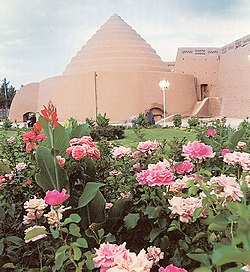Yakhchāl is Persian for ice pit and it’s an ancient type of evaporative cooler. Above ground, the structure has a domed shape with a subterranean storage space.
According to Wikipedia, these calling facilities were often used to store ice and food. The subterranean space coupled with the thick heat-resistant construction material insulated the storage space year round. These structures were mainly built and used in Persia (now Iran). Many that were built hundreds of years ago remain standing.
By 400 BCE, Persian engineers had mastered the technique of using yakhchāls to create ice in the winter and store it in the summer in the desert. Can you imagine that? Ice in the desert! In most yakhchāls, the ice is created by itself during the cold seasons of the year; the water is channeled from the qanat (Iranian aqueduct) to the yakhchāl and it freezes upon resting inside the structure. Usually a wall is also made along an east-west direction close to the yakhchāl and the water is channeled from the north side of the wall so that the shadow of the wall keeps the water cool to make it freeze more quickly. In some yakhchāls, ice is also brought in from nearby mountains for storage or to seed the icing process.
The buildi ng allows cold air to pour in from entries at the base of the structure and descend to the lowest part of the yakhchāl, large underground spaces up to 180,000 cu ft in volume. At the same time, the tall conical shape of the building guides any remaining heat upward and outside through openings at the very top of the building, and through this active process the air inside the yakhchāl remains cooler than the outside. The yakhchāl is built of a unique water resistant mortar called sarooj, composed of sand, clay, egg whites, lime, goat hair, and ash in specific proportions, that is resistant to heat transfer and is thought to be completely water impenetrable, this material acts as an effective insulation all year round. The sarooj walls are at least two meters thick at the base.
ng allows cold air to pour in from entries at the base of the structure and descend to the lowest part of the yakhchāl, large underground spaces up to 180,000 cu ft in volume. At the same time, the tall conical shape of the building guides any remaining heat upward and outside through openings at the very top of the building, and through this active process the air inside the yakhchāl remains cooler than the outside. The yakhchāl is built of a unique water resistant mortar called sarooj, composed of sand, clay, egg whites, lime, goat hair, and ash in specific proportions, that is resistant to heat transfer and is thought to be completely water impenetrable, this material acts as an effective insulation all year round. The sarooj walls are at least two meters thick at the base.
The ice created and stored in yakhchāl is used throughout the year especially during hot summer days for various purposes, including preservation of food, to chill treats, or to make faloodeh, the traditional Persian frozen dessert.
I’d like to have a go at building one. Have any of you tried this, or a variation on it?
Yakhchāl near Kerman, Iran
A yakhchāl in Kerman is located about one and a half kilometres from the centre of the city. This cone-shaped building is about eighteen metres high. The massive insulation and the continuous cooling waters that spiral down its side keep the ice frozen throughout the summer.
In present-day Iran, Afghanistan and Tajikistan, the term yakhchāl is also used to refer to modern household (and commercial) refrigerators.
